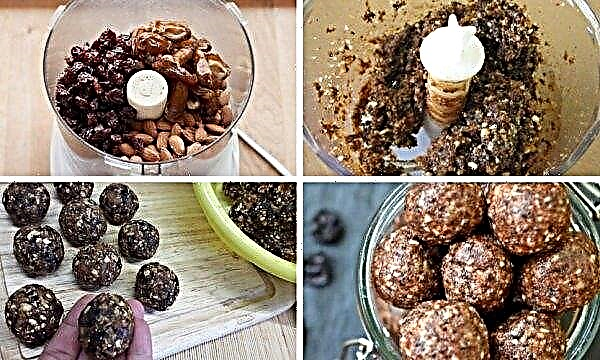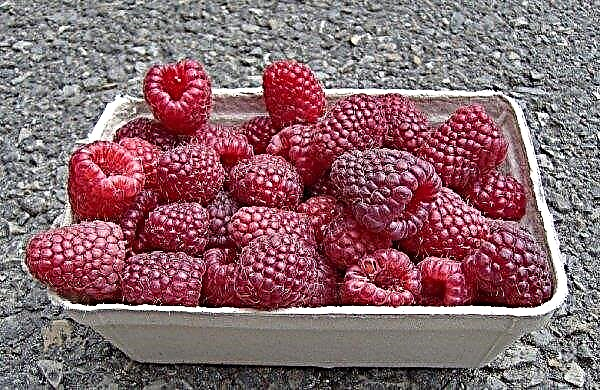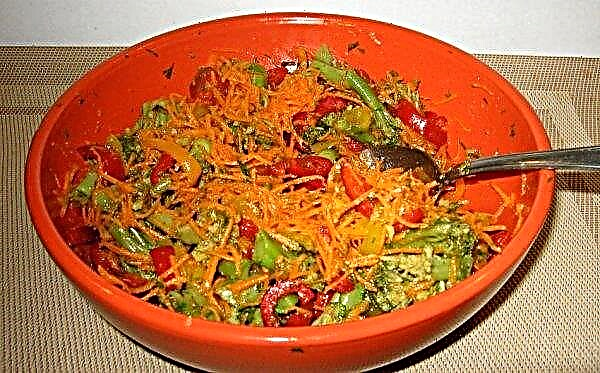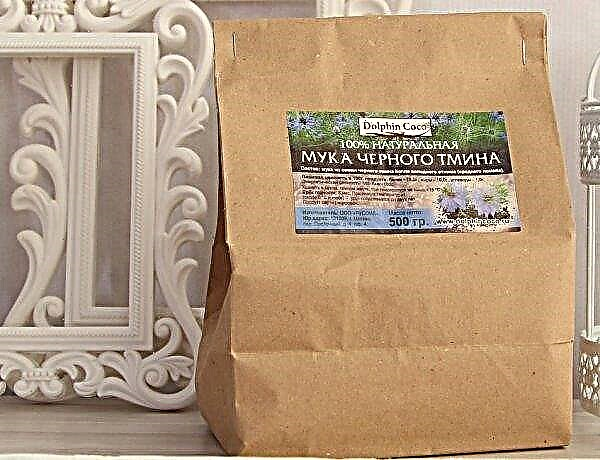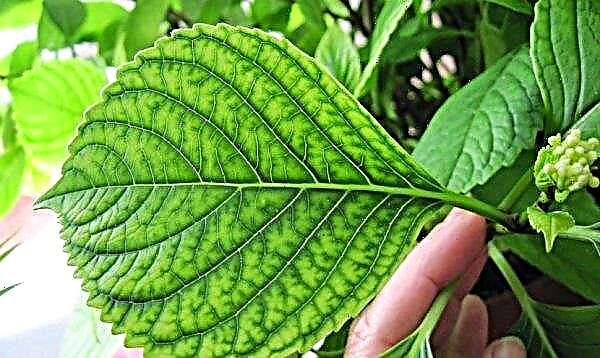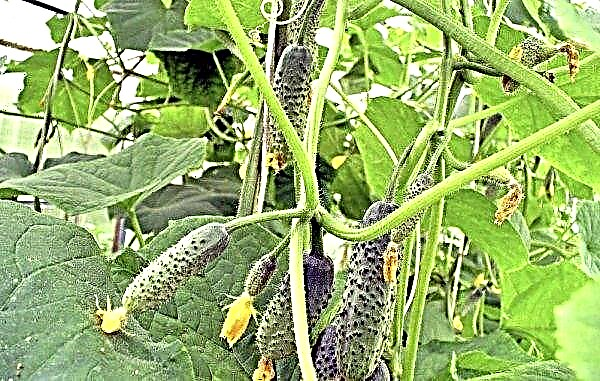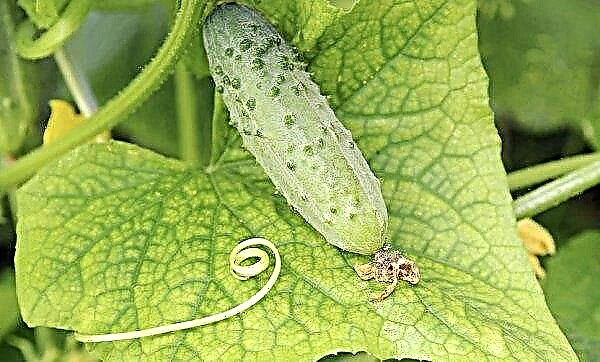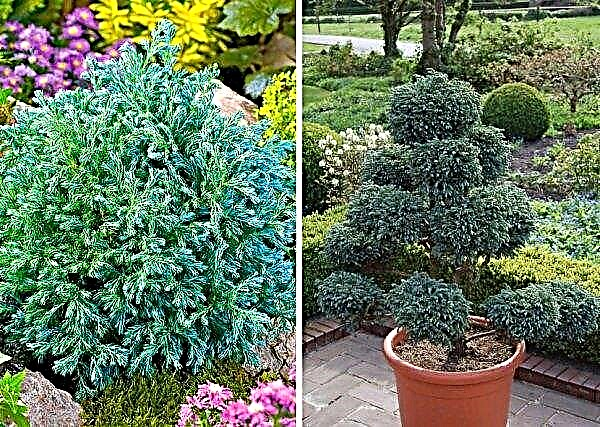The hybrid tomato variety Rosemary F1 is popular among gardeners due to its taste and high yield. The characteristic features of the tomato and the rules for growing it will be disclosed in this material.
Features and description of the variety
The rosemary F1 hybrid variety was bred by Russian breeders and entered into the State Register of Agricultural Crops in 2008. It is characterized by constant growth and average ripening times. From planting to harvesting, a period of 110–120 days passes. The crop in greenhouse conditions reaches a height of 180 cm, and in open ground less - up to 130 cm, has dark green leafy plates and stems. Greenhouse cultivation is recommended or under temporary cover.
Did you know? There are about 10 thousand varieties of tomatoes that differ in color and weight. The largest fruits reach a weight of 1.5 kg, and the smallest - only 20 g.
Description of the fruit:
- rounded shape, there is a noticeable ribbing at the peduncle;
- bright pink tint;
- the pulp is soft, has a loose structure, pale pink;
- fetal weight reaches 500 g;
- the skin is thin.

Advantages and disadvantages of the variety
Pink Rosemary F1 tomatoes are popular among gardeners who love sweet varieties. They are great for making sauces and juices. Rosemary F1 tomatoes are immune to fusarium and cladosporiosis, which distinguishes them from other hybrid varieties.
- The benefits of rosemary F1 tomatoes:
- large fruits of the same size;
- the bush has a powerful root system;
- the fruits are rich in vitamin A;
- are the basis of diet and baby food;
- harvesting is up to 12 kg with 1 m².
- In addition to the positive qualities, tomatoes have some disadvantages:
- quickly crack with a lack of moisture;
- due to the thin skin, they are practically unsuitable for transportation;
- when growing, they necessarily require garters to the trellis due to the large weight of the fruits.
Features of growing at home
Ideal for growing Rosemary F1 varieties are sandy loam soils, with a moderate addition of organic fertilizer, which is applied immediately before planting. Excessive fertilizer leads to twisting of leaf plates and a decrease in fruit collection.
Did you know? The composition of tomatoes includes serotonin — hormone that uplifting.
Optimal conditions
Tomatoes are thermophilic plants, therefore their cultivation is carried out at a temperature of +20 ... + 25 ° С. Intensive lighting contributes to the rapid development of the fruit, and also affects the yield and taste. Lack of lighting leads to disruption in the development of culture. If tomatoes are grown in a greenhouse, installation of additional lamp lighting is necessary. The optimal indicators of air humidity should not be higher than 60%, otherwise there is a risk of infection with fungal infections. High humidity negatively affects the fertilization of flower ovaries, because pollen can stick together and will not spill out of anthers.
The optimal indicators of air humidity should not be higher than 60%, otherwise there is a risk of infection with fungal infections. High humidity negatively affects the fertilization of flower ovaries, because pollen can stick together and will not spill out of anthers.
Preparation and sowing technology
Preparation of seed material for planting helps to accelerate seedlings and increase productivity. The surface of the seeds can be infected with infectious diseases that will lead to damage to the crop, so it is better to carry out their preliminary disinfection. It is necessary to soak the tomato seeds in clean water for 3 hours, and then place in a 1% solution of potassium permanganate for 6 hours.
To create a soil substrate you will need (in a ratio of 1: 1: 1: 1):
- the upper fertile soil layer (it is advisable to choose the soil on which the legumes grew);
- compost;
- peat;
- river sand.
Important! Ventilation is necessary for better drying of the soil after irrigation and improvement of the quality indicators of fruits, which, with a lack of ventilation, grow acidic and excessively watery in taste.
To obtain seedlings, you must perform the following steps:
- Choose a container. Usually take a box measuring 50 × 40 cm.
- Pour the prepared substrate to the top of the container.
- Plant seeds at a distance of 4 cm from each other by pressing 5-10 mm deep into the soil.
- After sowing the seed material, watering at room temperature (+ 20 ° C) should be done.
- Cover the container with cling film to create a greenhouse effect and accelerate the emergence of seedlings.
- When the first shoots appear after 7 days, you need to get rid of the film coating.
Video: sowing tomato seeds for seedlings
Follow-up care
In order for seedlings to develop correctly, you need to constantly change the position of the planting capacity. With periodic movement of the box, the sprouts do not bend due to a turn to the light. For germinating seedlings, an air temperature in the range of +23 ... + 28 ° C is necessary, this temperature regime is maintained until emergence. If the temperature regime is not observed, then the germination of seeds will deteriorate significantly and will take time up to 2-3 weeks. Throughout the period of germination, it is not worthwhile to expose a container with non-germinated seeds in the sun. With the advent of sprouts, the capacity must be rearranged in a cool, but more illuminated place, the temperature should not be higher than + 20 ° С. After 10 days, the seedlings must be rearranged in a warmer place with a temperature of about + 25 ° C. Watering seedlings can be done through a spray gun to prevent stagnation of water in the tank. Water should be warm and settled for 2 days.
Throughout the period of germination, it is not worthwhile to expose a container with non-germinated seeds in the sun. With the advent of sprouts, the capacity must be rearranged in a cool, but more illuminated place, the temperature should not be higher than + 20 ° С. After 10 days, the seedlings must be rearranged in a warmer place with a temperature of about + 25 ° C. Watering seedlings can be done through a spray gun to prevent stagnation of water in the tank. Water should be warm and settled for 2 days.
Dates and technology of planting seedlings
For growing in greenhouse conditions, tomato seedlings are planted in mid-March. The soil in the greenhouse must be fertilized, depending on its type:
- loamy soils are mixed with humus (10 kg) and sawdust (10 kg) per 1 m²;
- peat soil is mixed with 10 kg of sawdust, 10 kg of humus and 5 kg of sand per 1 m²;
- chernozem soils are mixed with 10 kg of sand per 1 m².
Before planting in open ground, seedlings are gradually accustomed to street temperature conditions by hardening. First, you just need to ventilate the room where the seedlings are stored, carrying out the procedure for several days, then the plants are taken out to the veranda or balcony for 2-3 hours, gradually increasing the plants' outdoor life for up to a day. Before transplanting in order to prevent diseases and pests, the sprouts treated with Bordeaux liquid (3%). Signs of seedling readiness for transplant:
Signs of seedling readiness for transplant:
- seedling height reached 35 cm;
- stems are thick;
- sprouts have 6–8 leaf plates.
Transplanting seedlings into the ground is as follows:
- Dig holes 15 cm deep, observing a distance between them of 40 cm and a width between rows of 50 cm.
- To soften the soil in pots with seedlings by abundant watering.
- Carefully remove the plants along with an earthen lump, wash off the soil under running water.
- Drive a peg with a height of at least 50 cm into each hole for further garter of the plants.
- To plant seedlings in the holes, melting the roots, to fill up with earth, loosely ramming.
- All pegs must be connected together by wire.
- Tie up the stems to the pegs.
Video: planting tomato seedlings in open ground
How to care for a variety of tomatoes
Compliance with the rules of caring for the crop contributes to its better development and increase yield. It is especially necessary to pay attention to ventilation in greenhouse conditions, which must be carried out daily. The optimum temperature for growing tomatoes in greenhouse conditions is + 25 ° C during the day and + 16 ° C at night.
Feeding and watering
Watering the plants must be done with settled water every 5 days, at the rate of 5 liters per 1 m², before flowering. After flowering, the volume of introduced liquid is increased to 10 liters per 1 m². It is necessary to water the crop under the root in order to avoid getting excessive moisture on the leaf plates.
Tomatoes are fed several times during the growing season:
- First feeding carried out 2 weeks after disembarkation. A solution prepared from 30 g of the Agricola Vegeta preparation, 15 g of nitrophoska and 5 l of water is excellent for this. The solution is applied under each bush for 1 liter.
- Second feeding is carried out after 2 weeks with a solution of Agricola Vegeta (30 g), the drug Effekton-O (30 g) and 5 l of water. Fertilizer is applied in 1 liter under each bush.
- Third feeding performed after 2 weeks after the second and consists of a solution that includes 15 g of superphosphate, 15 g of potassium in 5 l of water.
- Fourth feeding is the last, it is performed 2 weeks after the third. It is necessary to dilute 30 g of the Effekton-O preparation in 5 l of water and add 1 l under the root in each well.

Pasynkovka and formation of a bush
Plants of this variety need to periodically pinch - removal of shoots growing from the axils of the leaves. The procedure is carried out in the early morning, manually, pinching off unnecessary stepsons. If you do not carry out this procedure, then the plants will begin to branch strongly, which will lead to a lack of lighting and the development of diseases. Stepsons are removed 2 times a month, as the culture thickens.
The formation of the bush consists in cutting the lower leaf plates as they grow intensively. The bush is formed into 2 stems, selecting more developed stepsons and pruning them at the level with the main stalk. The crown of the central stem can be pinched to stop the growth of the culture and redirect all the nutrients to the fruits.
Soil cultivation and weeding
Loosening of the soil near the stem is carried out after each irrigation for better oxygen supply to the root system and an obstacle to the development of fungal infections. Weeding is carried out to a depth of 5-10 cm, with light movements, so as not to damage the rhizome.
Harvesting and storage
Harvesting the fruits of this variety begins in late July and continues until mid-September. Tomatoes should be stored in a clean, dry box, where they are neatly stacked in several rows. The fruits are covered with a lid on top so as not to damage them.
Important! Harvesting of tomatoes should be carried out every 4 days in order to prevent rotting and cracking of overripe fruits, as well as to enable immature vegetables to gain strength, gaining nutrients.
Disease treatment and prevention
Tomato diseases can be triggered by:
- lack of nutrients;
- excessive fertilizer;
- high humidity;
- pest infestation;
- overheating in the sun;
- excessive watering.
The most common diseases of tomatoes include late blight and dry spotting. Late blight is a fungal infection that provokes a change in the color of stems and leaf plates of tomatoes to brown. Vegetables rot, becoming brown.
Blight control:
- to limit moisture, watering is carried out only under the root, avoiding water entering the plant;
- irrigation with a tincture of garlic, which is made from 50 g of grated garlic and 1 g of potassium permanganate, diluted in 10 l of water;
- spraying with whey.
Dry spotting provokes the appearance of black spots with a glossy coating on vegetables with a diameter of 1-3 cm. Leaf blades acquire a yellow tint.
Dry Spot Control:
- irrigation of tomatoes with 1% Bordeaux liquid;
- removal of damaged leaf plates and fruits.
Parasites attacking tomato culture come in two forms:
- underground, which damage the root system;
- aboveground, which eat leaves, stems.
Pest Invasion Prevention:
- digging the soil in order to destroy the offspring of pests;
- mulching the soil with sawdust soaked in urea;
- soaking rhizomes of seedlings before planting for 6 hours in a solution of the drug "Prestige" (30 ml per 3 l of water);
- planting close with tomato crops that repel insects;
- seed disinfection before sowing in a 1% potassium permanganate solution.
In order to grow a rich crop of rosemary F1 tomatoes, you must follow the rules of care and carry out preventive treatment against diseases and pests. Timely application of fertilizing will increase the germination capacity of the culture and contribute to an increase in resistance to infections.


